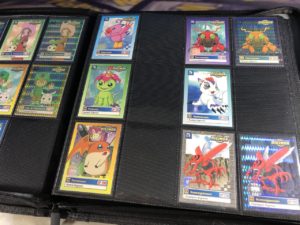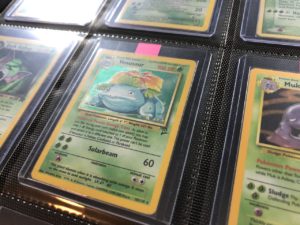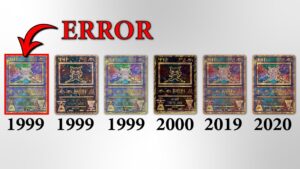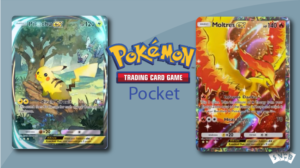Best Sleeves For Binders 2024
-
By: Oliver Copeland
- Published:
- Last Updated: February 6, 2024
So you’ve made the highly educated decision to store your cards in a binder, well done! But the next task is to determine which sleeves are the best for binder storage. This is going to depend on a variety of factors like which cards you’re keeping, your sleeve preference, and whether or not you’ll be transferring the cards often. But don’t worry, we’ll have an answer for any scenario.
Should You Sleeve Cards In A Binder?
The short answer is yes.
Binders are great for storage but are ideal for presentation and organization. Binders take up more space and hold fewer cards than a box, which doesn’t have practical value beyond its small size. If you want to occasionally flip through your binder pages and view your collection, a binder is key.
But binders can cause damage to your cards if not used properly. The pockets that are woven into the binder pages are slightly larger than most of your standard trading cards, and this allows for movement. Movement equals damage.
Using a sleeve is a must when storing your cards in a binder because it will keep them snug and protect the corners, edges, and surface from potential wear. In addition to this, most binders are water-resistant, but not waterproof. In the worst-case scenario, sleeves will add a layer of protection against moisture.
Make sure to buy the right binder
Binders to avoid
Back in the day, we used 3-ring binders with clear 9-pocket pages. Collectors no longer use this binder system as it’s poorly designed. We have better stuff now!
The rings can cause damage to your cards if the pages aren’t in place upon closing the binder. These are referred to as binder ring dings or dents and will ruin the value of a card. Instead, we now use binders that have the pages sewn into the binding.
The clear pages were usually top-loaded. This means that the opening to each pocket was at the top, and cards were prone to falling out if the binder was turned upside down.
Good binders
Today, we use high-grade card binders designed for the modern collector. These days, binders are made of nicer material and offer worry-free protection for your cards.

We recommend finding a binder without rings and with black stitched pages made with polypropylene side-loaded pockets.
No rings mean no dings or dents, and side-loaded pockets keep your cards from shuffling around or falling out.
Watch out for PVC pages
Polyvinyl chloride is a common material used for sleeves and binder pages. Unfortunately, this material breaks down over long periods of time and can cause damage to your cards. If this is your only option, it should be ok for short-term storage, but make a note to find a better material as soon as possible.
Instead of PVC, look for polypropylene pages. The packaging should usually tell you what materials are used, or you can always check the Amazon listing.
The Best Card Sleeves For Binders
When it comes to card sleeves, we have three common sizes to choose from, and each serves a different purpose.
Standard (2.5/8 “ X 3.5/8”)
Our Top Pick: Ultra Pro Clear Sleeves
These are standard poker-size sleeves. If you have sleeves, they are probably this size. This is going to fit most trading cards and levee a small margin of room on the sides and top. All binders are going to be made with this card size in mind, so the pockets are slightly bigger than a standard-size sleeve.
This size of sleeve will be perfectly fine for 99% of the binders on the market.
Inner (2.5” X 3.5”)
Our Top Pick: Ultra Pro Pro-Fit or DragonShield Resealable
An inner sleeve is a smaller size of sleeve. This size is designed to fit your cards perfectly, with a slim snug fitment. They are often called inner sleeves because they can be inserted into standard-size sleeves. This is known as double-sleeving and is probably a good idea.
You can double-sleeve your cards before storing them in a binder, but if you only have inner sleeves, that’s fine too!
Small (62 X 89mm)
Our Top Pick: TitanShield Inner Sleeves
Small sleeves fit crib-sized playing cards. Most trading cards are too big, being standard poker-sized, but Yu-Gi-Oh!, and some older trading cards like Topsun use the small size.
Lucky for us, small sleeves are pretty easy to find and readily available on sites like Amazon. But finding binders with smaller pockets is a challenge, unfortunately.
The good news is that you don’t really need a binder with smaller pockets. Yu-Gi-Oh! Cards will fit just fine and not move around if what you have is a good-quality binder. Try double-sleeving if the cards are moving around at all, and hopefully, the fit should be more snug.
Double-sleeving for binders
It’s not uncommon to double-sleeve your cards before inserting them into binder pockets. This adds additional padding so your card won’t slide around and of course, offers an extra layer of protection from dust, scratches, and wear.

The only time this could be detrimental is if the pockets are tight and don’t allow for that much material. You’ll usually notice an air pocket if this occurs. Air can get trapped in the sleeve and if the binder page pocket is too tight, it won’t be able to escape. These air pockets will add pressure and can damage your cards when the binder is closed.
Double-sleeving is simple and easy to do. Just insert your card into an inner sleeve, then insert it into a standard-size sleeve. Some collectors prefer to inverse the first sleeve so that there is no exposed edge once the card is double-sleeved.
Choosing the right sleeve material
Not all sleeves are created equal. Some sleeves can actually cause damage to your cards. If you read the packaging you’ll probably see “acid-free”, but this is just a buzzword and isn’t factually correct, so you want to instead look for “PVC Free”.
PVC sleeves won’t damage your cards short term. In fact, if you burn through a set of sleeves every month (due to a lot of gameplay), then PVC sleeves should be fine. The hidden dangers come from long-term storage.
The material polyvinyl chloride (PVC) is used all over the world and can be solid or flexible. But PVC can be dangerous, as it breaks down over time. This is noticeable by its yellowing, hardening, and oily traits. Collectors who used PVC sleeves throughout the 70s, 80s, and 90s have been affected the most, since almost all sleeves used to be made from PVC.
What you want to use are polypropylene sleeves. This is indicated by a number 5 with ‘PP’ below it. Polypropylene is an inert material that has heat-resistant properties. Most of the sleeves you own are probably polypropylene since it is now widely used for card sleeves.
Look for the word polypropylene on the packaging, or look for a recycling symbol with a ‘5′ in it.
Top Loader Binders
Of course, we have to mention top loader binders.

A top loader is also known as a ‘rigid’ sleeve, and that’s exactly what it is. It’s a larger, sturdier sleeve. These have various benefits but protection is the big one.
Top loader binders do exist. These are binders that have pockets designed specifically for top loaders. They can be expensive but do offer the utmost protection for your collection.
My personal favorite: Top Deck Top Loader Binder
You do have to use sleeves with top loaders though, otherwise, the card could slide around and become damaged.
Conclusion
So I mentioned the sleeves I recommend above, but you should also go explore your options and check out all the products available in your area. Remember to find a good binder if you haven’t already, without rings and with side-loaded pages. If you want to double-sleeve, then go ahead, it can’t hurt, right?

Hi, I'm Oliver. I've been collecting Pokémon cards for 25+ years. I hope you enjoyed your read and learned something. Learn more about me on the About page.




